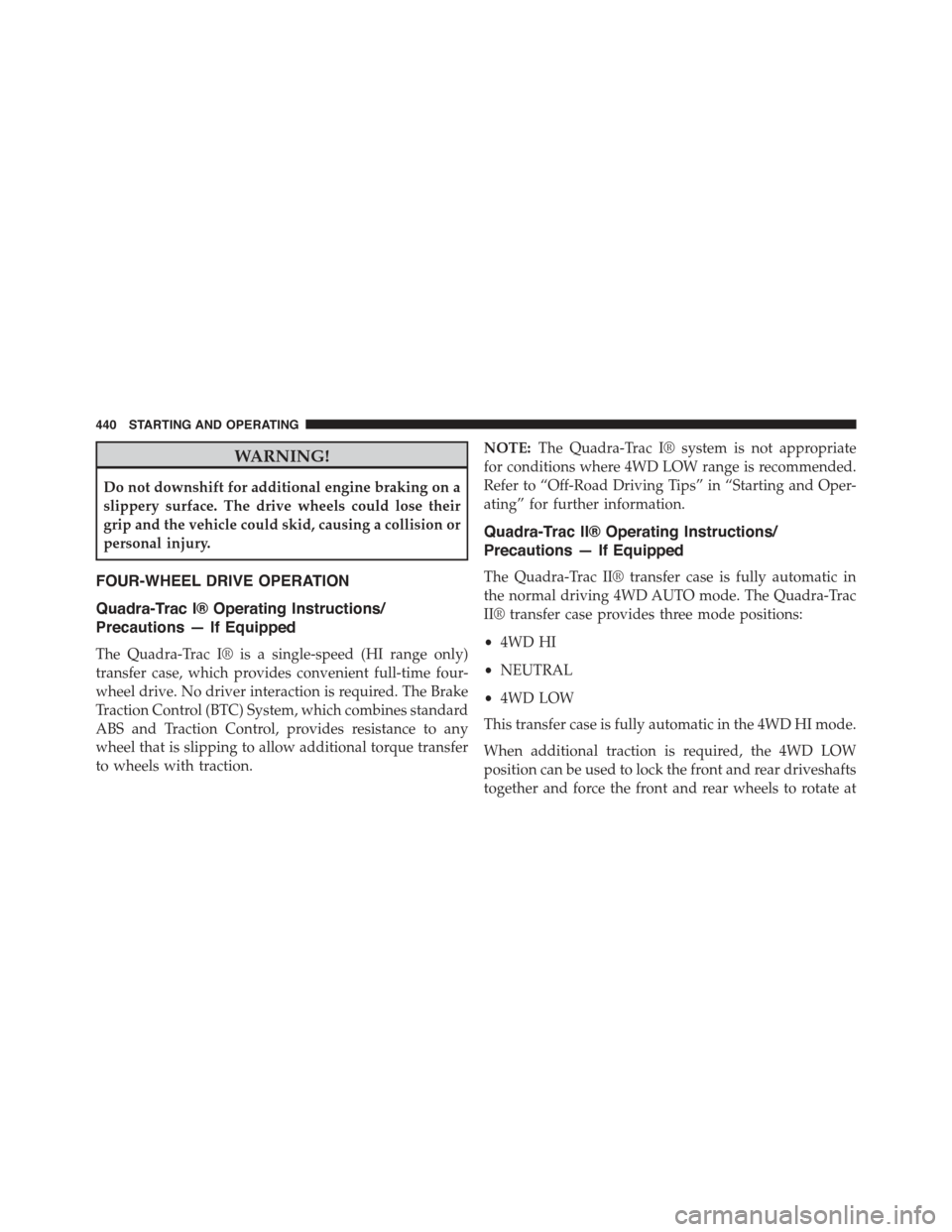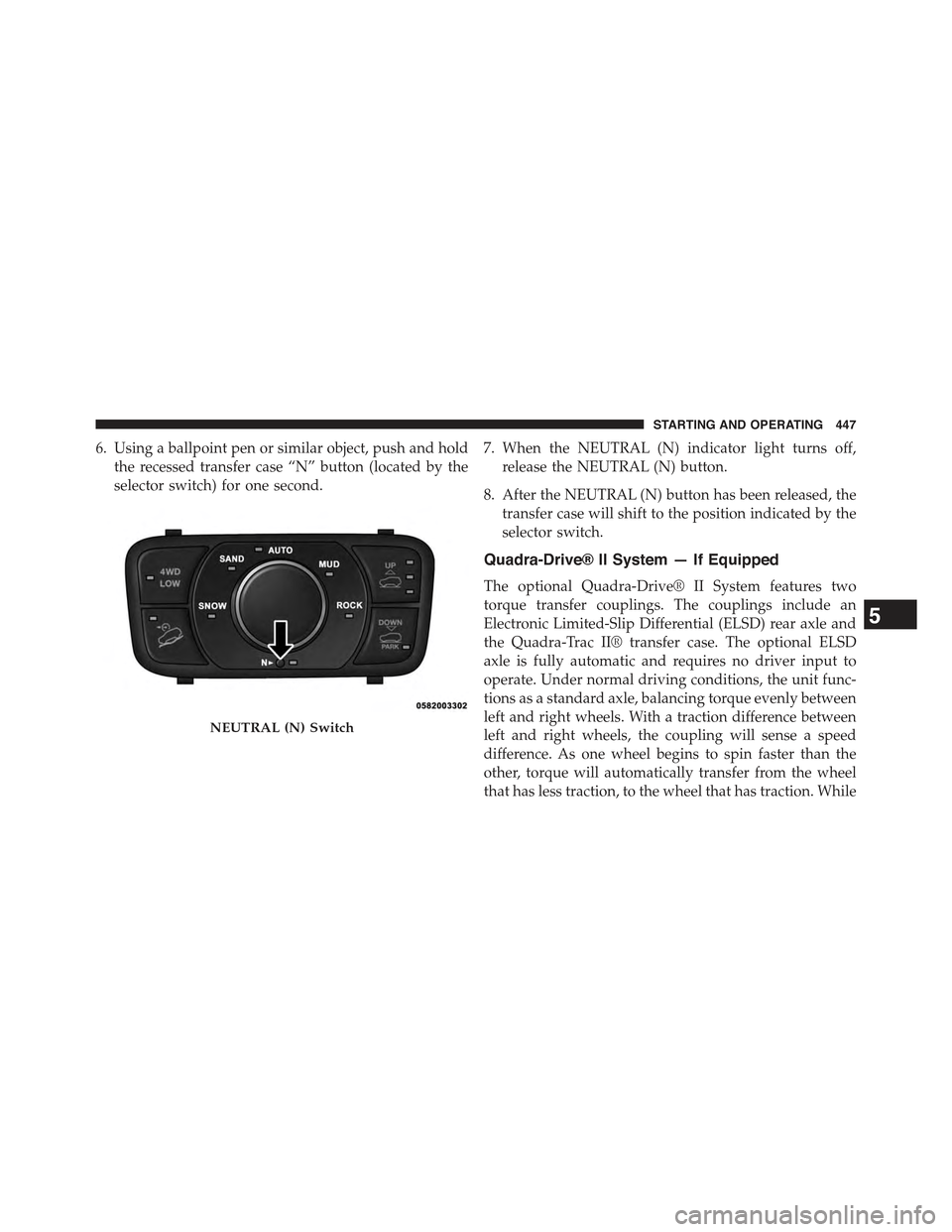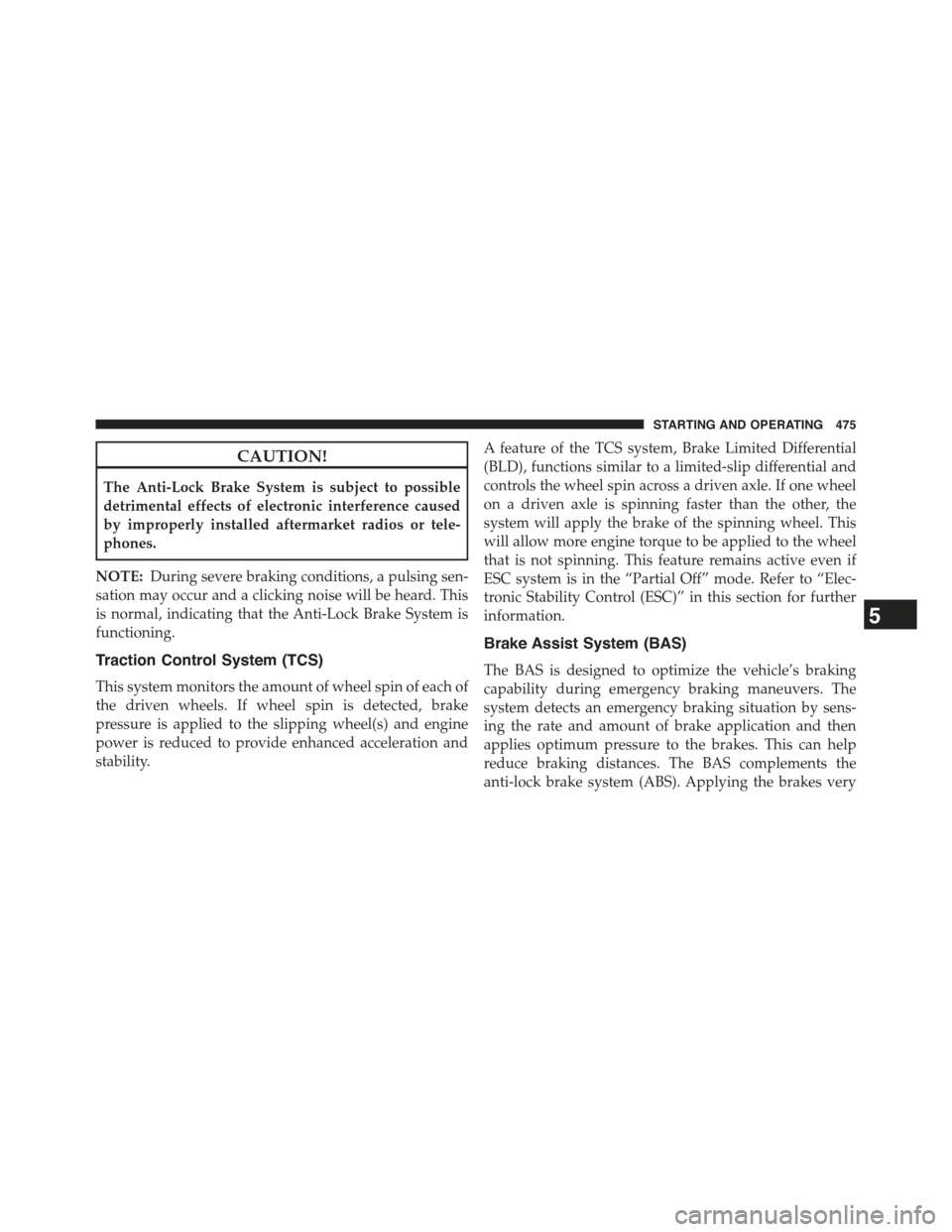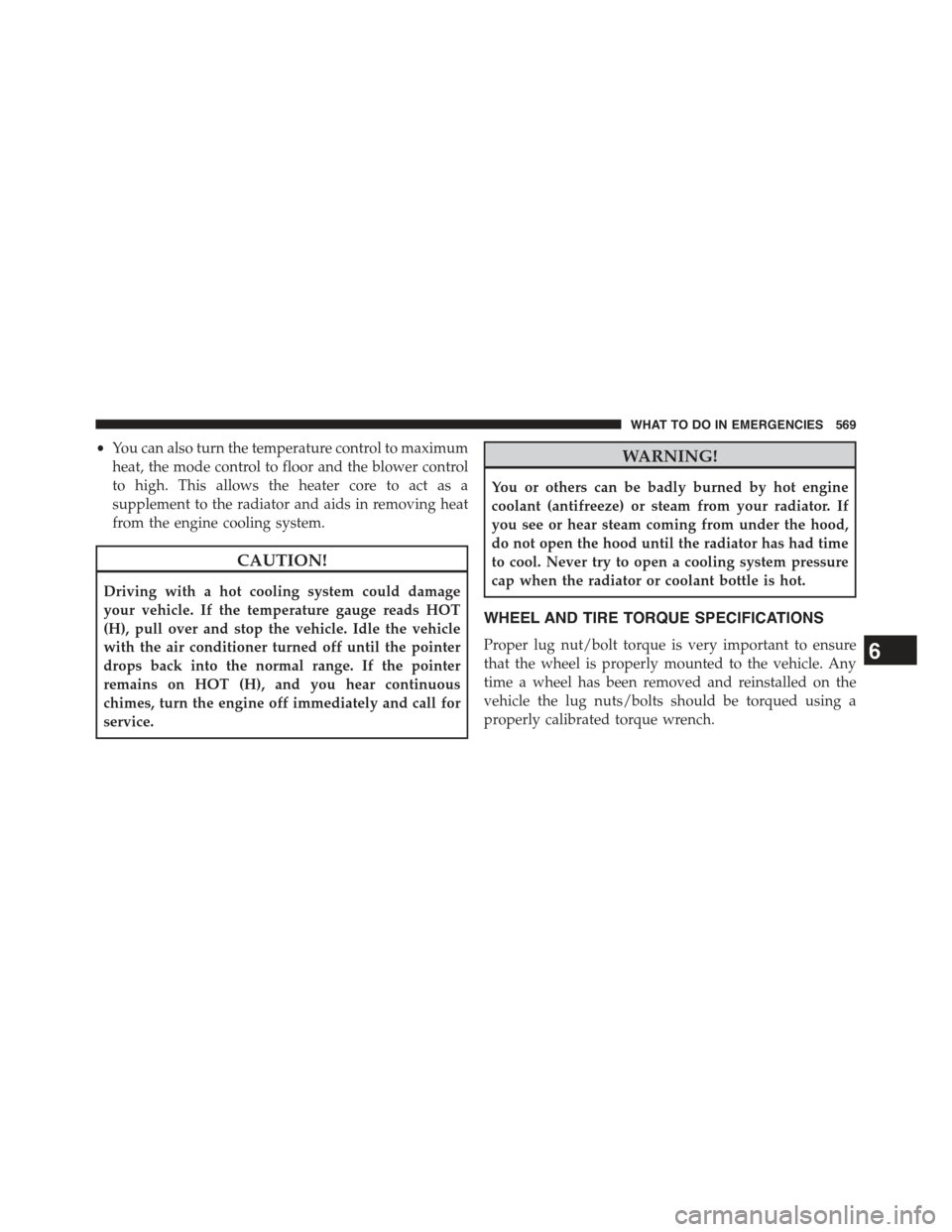Page 442 of 717

WARNING!
Do not downshift for additional engine braking on a
slippery surface. The drive wheels could lose their
grip and the vehicle could skid, causing a collision or
personal injury.
FOUR-WHEEL DRIVE OPERATION
Quadra-Trac I® Operating Instructions/
Precautions — If Equipped
The Quadra-Trac I® is a single-speed (HI range only)
transfer case, which provides convenient full-time four-
wheel drive. No driver interaction is required. The Brake
Traction Control (BTC) System, which combines standard
ABS and Traction Control, provides resistance to any
wheel that is slipping to allow additional torque transfer
to wheels with traction.
NOTE:The Quadra-Trac I® system is not appropriate
for conditions where 4WD LOW range is recommended.
Refer to “Off-Road Driving Tips” in “Starting and Oper-
ating” for further information.
Quadra-Trac II® Operating Instructions/
Precautions — If Equipped
The Quadra-Trac II® transfer case is fully automatic in
the normal driving 4WD AUTO mode. The Quadra-Trac
II® transfer case provides three mode positions:
•4WD HI
•NEUTRAL
•4WD LOW
This transfer case is fully automatic in the 4WD HI mode.
When additional traction is required, the 4WD LOW
position can be used to lock the front and rear driveshafts
together and force the front and rear wheels to rotate at
440 STARTING AND OPERATING
Page 445 of 717
4WD LOW
This range is for low speed four-wheel drive. It provides
an additional gear reduction which allows for increased
torque to be delivered to both the front and rear wheels
while providing maximum pulling power for loose,
slippery road surfaces only. Do not exceed 25 mph
(40 km/h).
NOTE:Refer to “Selec-Terrain® – If Equipped” for fur-
ther information on the various positions and their
intended usages.
Shifting Procedures
4WD HI To 4WD LOW
With the vehicle at speeds of 0 to 3 mph (0 to 5 km/h), the
ignition switch in the ON position or the engine running,
shift the transmission into “N”, and push the “4WD
LOW” button once on the transfer case switch. The “4WD
LOW” indicator light in the instrument cluster will begin
to flash and remain on solid when the shift is complete.
Transfer Case Switch
5
STARTING AND OPERATING 443
Page 449 of 717

6. Using a ballpoint pen or similar object, push and hold
the recessed transfer case “N” button (located by the
selector switch) for one second.
7. When the NEUTRAL (N) indicator light turns off,
release the NEUTRAL (N) button.
8. After the NEUTRAL (N) button has been released, the
transfer case will shift to the position indicated by the
selector switch.
Quadra-Drive® II System — If Equipped
The optional Quadra-Drive® II System features two
torque transfer couplings. The couplings include an
Electronic Limited-Slip Differential (ELSD) rear axle and
the Quadra-Trac II® transfer case. The optional ELSD
axle is fully automatic and requires no driver input to
operate. Under normal driving conditions, the unit func-
tions as a standard axle, balancing torque evenly between
left and right wheels. With a traction difference between
left and right wheels, the coupling will sense a speed
difference. As one wheel begins to spin faster than the
other, torque will automatically transfer from the wheel
that has less traction, to the wheel that has traction. While
NEUTRAL (N) Switch
5
STARTING AND OPERATING 447
Page 467 of 717

Traction Downhill
When descending mountains or hills, use Hill Descent or
Selec-Speed Control to avoid repeated heavy braking.
If not equipped with Hill Descent or Selec-Speed Control
use the following procedure:
Shift the transmission into a low gear, and the transfer
case into 4WD LOW range. Let the vehicle go slowly
down the hill with all four wheels turning against engine
compression drag. This will permit you to control the
vehicle speed and direction.
When descending mountains or hills, repeated braking
can cause brake fade with loss of braking control. Avoid
repeated heavy braking by downshifting the transmis-
sion whenever possible.
After Driving Off-Road
Off-road operation puts more stress on your vehicle than
does most on-road driving. After going off-road, it is
always a good idea to check for damage. That way you
can get any problems taken care of right away and have
your vehicle ready when you need it.
•Completely inspect the underbody of your vehicle.
Check tires, body structure, steering, suspension, and
exhaust system for damage.
•Inspect the radiator for mud and debris and clean as
required.
•Check threaded fasteners for looseness, particularly on
the chassis, drivetrain components, steering, and sus-
pension. Retighten them, if required, and torque to the
values specified in the Service Manual.
•Check for accumulations of plants or brush. These
things could be a fire hazard. They might hide damage
to fuel lines, brake hoses, axle pinion seals, and
propeller shafts.
5
STARTING AND OPERATING 465
Page 477 of 717

CAUTION!
The Anti-Lock Brake System is subject to possible
detrimental effects of electronic interference caused
by improperly installed aftermarket radios or tele-
phones.
NOTE:During severe braking conditions, a pulsing sen-
sation may occur and a clicking noise will be heard. This
is normal, indicating that the Anti-Lock Brake System is
functioning.
Traction Control System (TCS)
This system monitors the amount of wheel spin of each of
the driven wheels. If wheel spin is detected, brake
pressure is applied to the slipping wheel(s) and engine
power is reduced to provide enhanced acceleration and
stability.
A feature of the TCS system, Brake Limited Differential
(BLD), functions similar to a limited-slip differential and
controls the wheel spin across a driven axle. If one wheel
on a driven axle is spinning faster than the other, the
system will apply the brake of the spinning wheel. This
will allow more engine torque to be applied to the wheel
that is not spinning. This feature remains active even if
ESC system is in the “Partial Off” mode. Refer to “Elec-
tronic Stability Control (ESC)” in this section for further
information.
Brake Assist System (BAS)
The BAS is designed to optimize the vehicle’s braking
capability during emergency braking maneuvers. The
system detects an emergency braking situation by sens-
ing the rate and amount of brake application and then
applies optimum pressure to the brakes. This can help
reduce braking distances. The BAS complements the
anti-lock brake system (ABS). Applying the brakes very
5
STARTING AND OPERATING 475
Page 490 of 717
Selec Speed Control (SSC) — If Equipped
(Four-Wheel Drive Models With MP3023
Two-Speed Transfer Case Only)
SSC is intended for off road driving in 4WD Low Range
only. SSC maintains vehicle speed by actively controlling
engine torque and brakes.
SSC has three states:
1. Off (feature is not enabled and will not activate)
2. Enabled (feature is enabled and ready but activation
conditions are not met, or driver is actively overriding
with brake or throttle application)
3. Active (feature is enabled and actively controlling
vehicle speed)
Enabling SSC
SSC is enabled by pressing the SSC switch, but the
following conditions must also be met to enable SSC:
•Driveline is in 4WD Low Range
•Vehicle speed is below 5mph (8 km/h)
•Parking brake is released
•Driver door is closed
•Driver is not applying throttle
Selec Speed Control Switch
488 STARTING AND OPERATING
Page 569 of 717
WHAT TO DO IN EMERGENCIES
CONTENTS
!HAZARD WARNING FLASHERS...........568
!IF YOUR ENGINE OVERHEATS............568
!WHEEL AND TIRE TORQUE
SPECIFICATIONS......................569
▫Torque Specifications...................570
!JACKING AND TIRE CHANGING..........571
▫Jack Location........................572
▫Spare Tire Stowage....................573
▫Preparations For Jacking................573
▫Jacking Instructions...................575
▫Road Tire Installation...................581
!JUMP-STARTING......................582
▫Preparations For Jump-Start..............583
▫Jump-Starting Procedure................585
!FREEING A STUCK VEHICLE.............587
!EMERGENCY TOW HOOKS — IF EQUIPPED . .588
!MANUAL PARK RELEASE................589
!TOWING A DISABLED VEHICLE...........593
▫Two-Wheel Drive Models................595
▫Four-Wheel Drive Models................596
6
Page 571 of 717

•You can also turn the temperature control to maximum
heat, the mode control to floor and the blower control
to high. This allows the heater core to act as a
supplement to the radiator and aids in removing heat
from the engine cooling system.
CAUTION!
Driving with a hot cooling system could damage
your vehicle. If the temperature gauge reads HOT
(H), pull over and stop the vehicle. Idle the vehicle
with the air conditioner turned off until the pointer
drops back into the normal range. If the pointer
remains on HOT (H), and you hear continuous
chimes, turn the engine off immediately and call for
service.
WARNING!
You or others can be badly burned by hot engine
coolant (antifreeze) or steam from your radiator. If
you see or hear steam coming from under the hood,
do not open the hood until the radiator has had time
to cool. Never try to open a cooling system pressure
cap when the radiator or coolant bottle is hot.
WHEEL AND TIRE TORQUE SPECIFICATIONS
Proper lug nut/bolt torque is very important to ensure
that the wheel is properly mounted to the vehicle. Any
time a wheel has been removed and reinstalled on the
vehicle the lug nuts/bolts should be torqued using a
properly calibrated torque wrench.
6
WHAT TO DO IN EMERGENCIES 569